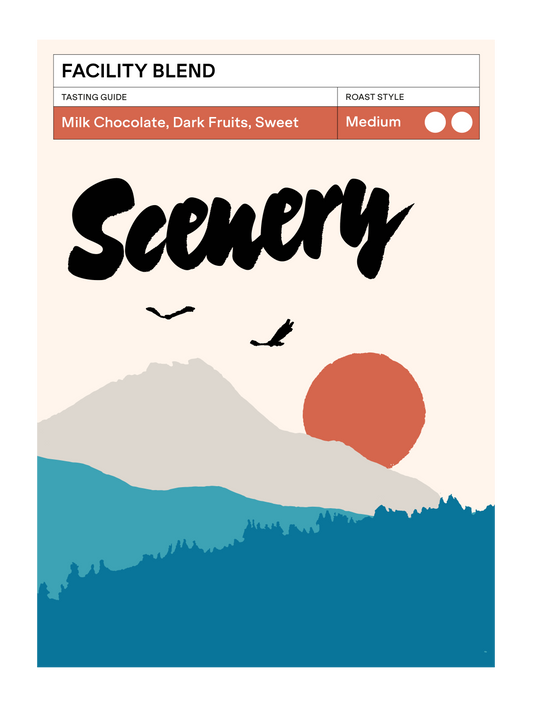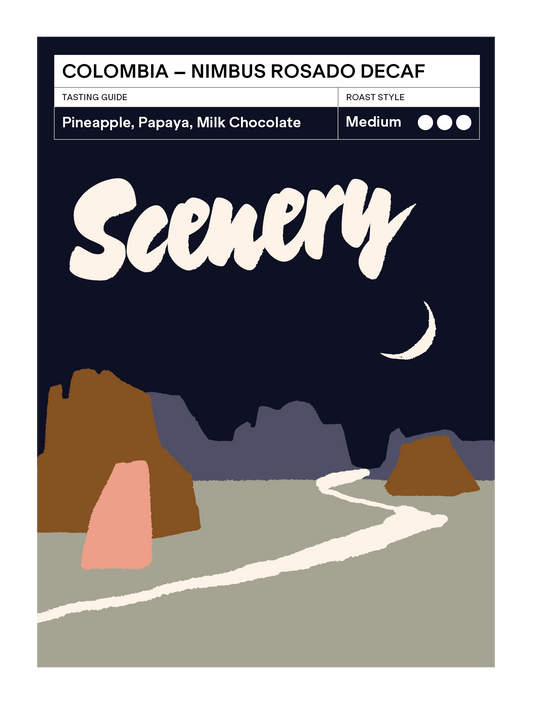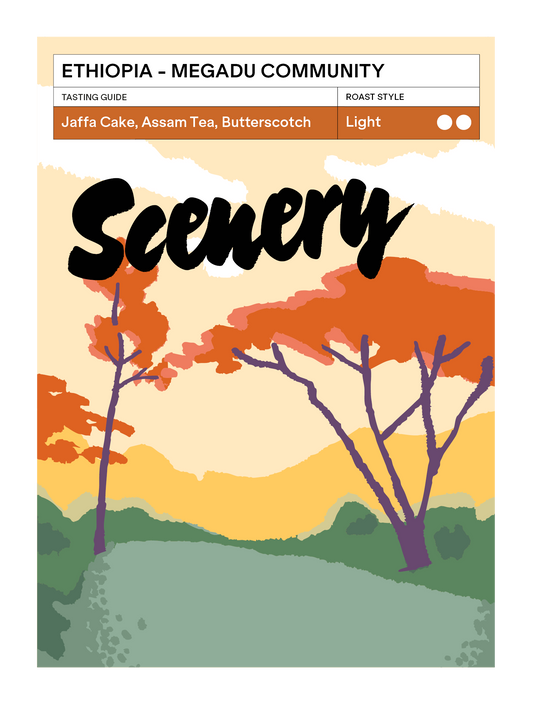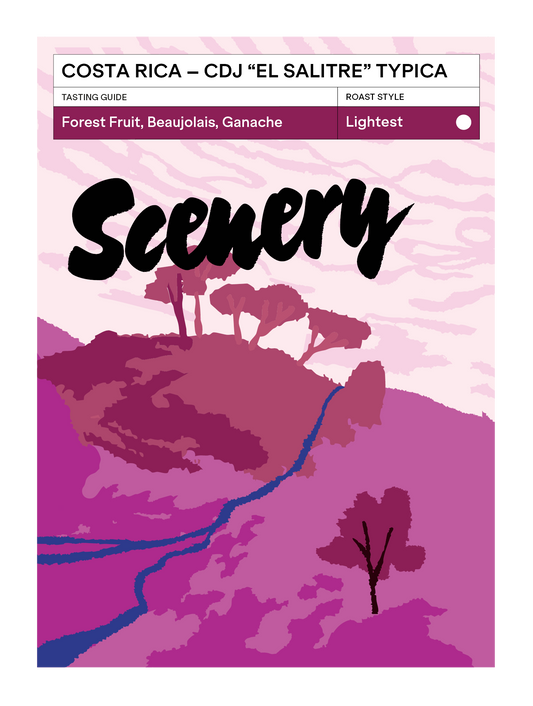This absolute banger of a natty Eth ran from 26/06/2024 to 18/09/2024.
Our first Ethiopian release of the season sees us continue our buying partnership with Coffee Legends & the inimitable Daye Bensa PLC. Rumudamo is a station with serious pedigree - placing 2nd and 3rd in the first Ethiopian cup of excellence.
This naturally processed lot blew us away with how clean, complex and layered it presented to us on our offer sample cuppings, an instant buy and one sorely awaited to land in the UK.
Brew Guide:
Best Brewed with: Filter
Super juicy, floral and top note dominated - this is as far from funky as a natural can be. A super light level of roaster influence preserves the aromatic and acidity complexity that this coffee has oodles of.
Best rested for: 3-4 weeks
For Filter: We recommend a ratio of 65g/L, 94°C water to brew a total juice bomb. 58g/L and 98°C, with finer grind brings out subtle complexity.
For Espresso: 18g in, 50g out, 20-25s turbo-style shots are our preference for peak juice.
We’re tasting:
Very floral - sweet rose and candied bergamot aroma. The cup is tropical, bright and clean - pineapple and wild strawberry sweetness but with a distinct wild rose florality. On cool, a hint of rambutan.
Traceability:
Country of Origin: |
Ethiopia |
Region: |
Arbegona, Sidama |
Farm: |
Rumudamo washing station |
Producer: |
600 smallholder farmers selling cherry to Rumudamo, which is managed by Asefa Dukamo Korma |
Variety: |
Primarily JARC 74112, alongside 74110 and 74158 |
Elevation: |
2100- 2330 MASL, station at 2200 MASL. |
Process: |
Natural: Ripe cherries picked and delivered to Rumudamo. Cherries floated to remove underripes and debris before being dried as a traditional African Natural on raised beds. Cherries are covered during peak mid-day sun, and moved fully under shade if the daytime temperature is too hot. Drying takes an average of 20 days, with defects removed by hand during this period. |
Import Partner: |
Coffee Legends via Daye Bensa |
Harvest |
Crop 23/24, Arrived UK: June 24 |
The Story
We’ve made a commitment to try and work with producer owned value chains wherever possible. This means that those that grow the coffee, also manage the exporting and importing process ensuring that the maximum value for our purchase is returned upstream. This means both working with smaller independent outfits, as well as larger operations.
Daye Bensa was founded by two brothers - Asefa and Mulugeta in 1996, setting up a farm and washing station in the Bensa region of Sidama. Initially only selling internally (as Ethiopia has a strong internal market for coffee - around 50% of what is grown in Ethiopia never leaves its borders), in 2006 they started exporting coffee internationally. Since then, Daye Bensa has grown to be one of the top 5 largest international exporters by volume (and most assuredly higher by quality!) in Ethiopia, but still to this day family owned and based in-country.
Atrie from Coffee Legends is Asefa’s brother in law - having worked as a manager for Daye Bensa, with a stint in finance in the UK, he took the leap to set up a UK import office for Daye Bensa. Atrie’s mission is to specifically highlight and promote the Arbegona region of Sidama - a relatively youthful area for coffee production.
Arbegona represents an interesting example of the future of coffee - but perhaps not as we would like to see. It is no secret that Arabica coffee trees are fussy plants - even in their native Ethiopia, they have a defined climactic range in which they flourish. They thrive best with daytime temperatures no higher than 25-30c, with a cooler nighttime temperature. As global and local temperatures crank ever upwards, coffee production in lower altitudes is in crisis - the heat stress diminishing yields, increasing susceptibility to disease and insect damage, and when we consider cup attributes, hotter temps lead to rapid cherry maturation and poor quality. Slowly but surely lower altitude regions no longer become suitable for growing coffee as the global temps rise.
Arbegona is an example of the counter-point of this - as temperatures rise and lower altitude areas become unsuitable, regions that were previously too high and too cold for production become viable. Arbegona is home to higher elevations than the surrounding classic woredas of Sidama, elevations that common wisdom over 30 years ago would have said no coffee would grow. But as temperatures rise, farmers have had success growing extremely high altitude coffee - some of the highest grown in the world.
Unlike other regions with longer histories, the majority of coffee production in Arbegona is recent plantings, mostly Jimma Agricultural Centre improved cultivars (as opposed to a mixture of JARC and local selected landraces). This means we can be very confident in discussing which varieties have built the lot, and we see a more defined flavour profile from the 3 JARC varieties typically planted in the region. Secondly, the extremely high altitude is still not completely conquered by the rising climates - cooler nights ensure that cherry maturation is a slow process, and often the cherries themselves are incredibly small. Dense, tiny beans but packed full of intensity and flavour from the conditions. It’s no wonder when you combine this with quality focused protocols and processing that Arbegona is quickly picking up a reputation for top, top quality production, a reputation to rival the most storied kebeles.
But it’s tinged with mourning - while we gain access to new regions inside the motherland of coffee, with incredible and distinct profiles, the lingering thought always returns - what happens when “low altitude conditions” cover the majority of the coffee lands across the globe, and there are no more mountains to climb?

![[27] Ethiopia - Rumudamo [CROP 23/24 ARCHIVE]](http://scenery.coffee/cdn/shop/articles/ethiopia_rumudamo_shopify.png?v=1727427685&width=1100)
![Colombia - Quebraditas Ají Thermal Shock Washed [FESTIVE SPECIAL] 🎄](http://scenery.coffee/cdn/shop/files/colombia_quebraditas_aji_shopify.png?v=1764358600&width=533)






![Colombia - Quebraditas Sidra Thermal Shock Washed [25/26]](http://scenery.coffee/cdn/shop/files/colombia_quebraditas_sidra_2526_shopify.png?v=1765544630&width=533)



![Colombia - Luz Ángela's Chiroso [25/26]](http://scenery.coffee/cdn/shop/files/colombia_luz_angela_chiroso_2526_shopify.png?v=1764359755&width=533)


![Colombia - El Jaragual Rosado [25/26]](http://scenery.coffee/cdn/shop/files/el_jaragual_rosado_2526.png?v=1757075842&width=533)